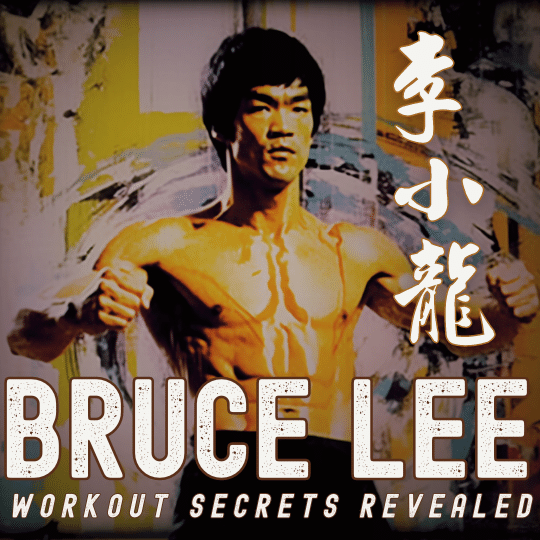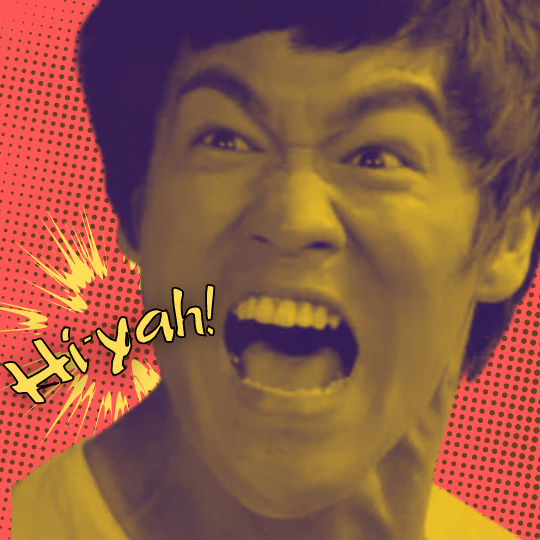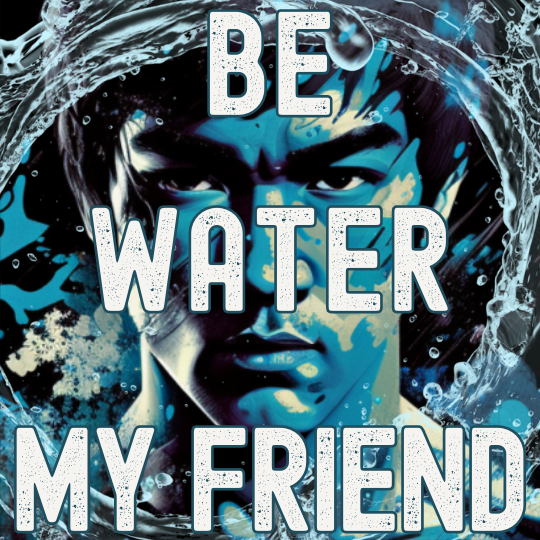
The impact of Bruce Lee’s movies on martial arts was immense. He popularized the idea of a hybrid fighting style, incorporating elements of different martial arts into his own, and revolutionized how martial arts were depicted on screen.
His movies, including “Fist of Fury” and “Enter the Dragon,” showcased his incredible physical abilities and unique fighting style, inspiring a generation of martial artists and action movie stars. To this day, Bruce Lee is considered a legend in the martial arts world, and his influence continues to be felt in the industry.


Skip To
- The Big Boss (1971)
- Fist of Fury (1972)
- Way of the Dragon (1972)
- Enter the Dragon (1973)
- Game of Death (1978)
*Please note that some of the links in this content may be affiliate links, meaning that I may receive a small commission if you purchase through them.
Why Bruce Lee Is Famous
Many more films have been made about Bruce Lee than he ever made himself. After his death, the Hong Kong film industry saw a rise in the number of Bruce Lee imitators, including Bruce Li, Bruce Lai and many others. These films capitalized on Lee’s popularity and tried to recreate his iconic fighting style and onscreen presence. While these films enjoyed some commercial success, they were seen by many as cheap imitations of the real thing. They could not match the depth and intensity of Lee’s performances. Nevertheless, they played an essential role in keeping Bruce Lee’s memory alive and helped cement his legacy as one of the most incredible action stars of all time.
Bruce Lee’s movies played a significant role in introducing Eastern philosophy to Western audiences. Through his films, he conveyed essential principles such as mindfulness, self-awareness, physical fitness, and the pursuit of self-discipline. In addition, he emphasized the importance of the mental and spiritual aspects of martial art. He showed how they could be applied to everyday life.
Lee’s philosophy of “Be Like Water” encouraged fluidity and adaptability, making it a central theme in his movies. As a result of his unique approach to martial arts and the popularity of his films, Bruce Lee helped popularize Eastern philosophy and spirituality in the West, influencing countless people to embrace these principles and philosophies.
Rise of The Dragon

Lee had a family history of acting. His father was Lee Hoi-Chuen, a Cantonese opera star and film actor. The elder Lee rose to prominence when he refused to make propaganda films for the Japanese during the occupation. As a result of his reputation for being a patriot, Lee Hoi-Chuen appeared in over 1,000 movies and was considered one of the most talented actors of his time. He was also a talented musician and singer, and audiences highly acclaimed his performances in Hong Kong and throughout Asia. Despite his success as an actor, Lee Hoi-Chuen struggled for a time with opium addiction and was largely an absent father due to his successful career. This contributed to the young Bruce getting involved with gangs and violence on the streets of Hong Kong. This eventually led to the elder Lee sending Bruce to America.
With his family connections in the industry, Bruce Lee naturally began his acting career as a child in Hong Kong. He appeared in numerous films and TV shows, showcasing his charisma and screen presence from a young age. Lee’s early acting experience taught him valuable skills. It helped him develop the confidence and stage presence that would later make him a legendary martial arts star.
Are Bruce Lee Movies Connected?
Watching Bruce Lee’s movies in order is not necessary to appreciate his legacy and impact. Each of his films stands alone as a showcase of his exceptional skills, unique philosophy, and captivating personality. It’s more important to focus on the content and messages of the films rather than their order.
While it is interesting to see the evolution of Bruce Lee’s career and screen presence, it is not necessary to follow a specific order to appreciate his talent and impact on martial arts cinema. Instead, focus on finding the films that resonate with you and enjoy the thrill of Bruce Lee’s electrifying martial arts displays. So whether you start with “The Big Boss” or “Enter the Dragon,” you will be entertained and inspired by this martial arts legend.
History & Background

The story of Lee’s movies and Kung Fu cinema as a whole, with its many cult classics, stretches back to Cantonese Opera. There was a relationship between Cantonese Opera and secret societies like the Red Boat Society, which practiced Wing Chun and used the Opera as a front for their political activities. Cantonese Opera enjoyed its peak popularity at the end of the 19th and early 20th Centuries.
In the 1920s, with the introduction of moving pictures, three brothers with roots in Cantonese Opera formed a new movie production company called Tianyi. Tianyi would become more commonly known in the West as “Shaw Bros. Studios.” Initially, the Shaw Brothers mainly produced dramatic films. However, beginning in the 1960s focus shifted to martial arts. They released kung fu classics The Magnificent Concubine in 1962 and The One Armed Swordsmen in 1967.
In 1970, notable film producers Raymond Chow and Leonard Ho left the Shaw Bros. to start their own film production company called Golden Harvest, which took a more decentralized approach to filmmaking as opposed to the tightly controlled, top-down approach favored by Shaw Brothers.
A New Era Dawns

Enter The Dragon, 1973
In 1971, Golden Harvest took the world by storm when they collaborated with the rising young star Bruce Lee on The Big Boss. While Lee hadn’t yet been able to land a leading role in a Hollywood film, he was already attracting attention in some notable Hollywood TV productions, most notably for his recurring role as Kato in the Green Hornet series.
After Lee’s death from cerebral edema in 1973, Golden Harvest went on to produce many more great Kung Fu classics with Jackie Chan, Sammo Hung as well as Donnie Yen, while the Shaw Brothers released several cult classics in the late 70s like The Five Deadly Venoms and The 36th Chamber of Shaolin (currently free on Amazon Prime!).
Which Bruce Lee Movies To Watch
No matter which film you choose to watch, they are all entertaining and inspiring. Every film showcases Lee’s incredible martial arts skills and captivating on-screen presence. Whether you’re a fan of martial arts, action films, or simply great storytelling, you won’t be disappointed.
Here is a brief synopsis of Lee’s films, along with a list of some other famous martial artists!
The Big Boss
Bruce Lee plays Cheng Chao-an, who moves to Thailand to work in an ice factory and discovers illegal activities. He finds himself caught up in the dangerous underworld and must use his martial arts skills to survive.
Watch The Big Boss on Amazon Prime.
Fist of Fury
Bruce Lee plays Chen Zhen, a student of martial arts who seeks revenge for the death of his teacher Huo, Yuanjia. Chen travels to Shanghai to confront the people responsible, leading to a series of battles that showcase Lee’s incredible fighting abilities. While the character of Chen Zhen was fictional, Hua, Yuanjia was a historical figure in Chinese martial arts. You can read more about Master Huo in our article on the History of Kung Fu.
Watch Fist of Fury on Amazon Prime.
Fun Fact: according to IMBD, there was a mix up with Bruce Lee’s first two films released in the US.
“The Big Boss was originaly released in the U.S. under the title “Fist of Fury”. This movie was shipped to the states along with Bruce Lee’s other film The Chinese Connection. However, due to the films being shipped in the wrong containers the titles were swapped. “The Chinese Connection” was supposed to be titled “Fist of Fury” in the U.S. and “Fist of Fury” (the original U.S. title of “The Big Boss”) was supposed to be released as “The Chinese Connection”. Decades later they were finally recognized in the U.S. by the original chinese titles.”
imdb.com/ The Big boss Trivia
Bruce Lee And Chuck Norris
Way of the Dragon
Bruce Lee both directs and stars in this film as Tang Lung, a martial arts expert sent to Rome to help protect a restaurant from gangsters.
The film is famous for its final showdown between Lee and Chuck Norris in the Colosseum. Chuck Norris played the role of Colt, a martial arts expert hired to take out Tang Lung.
The fight between the two legends is widely regarded as one of the best onscreen martial arts battles of all time, showcasing both Lee’s incredible speed and power and Norris’s impressive techniques and athleticism.
Experience the legendary showdown in 'Way of the Dragon', where martial arts icons Bruce Lee and Chuck Norris deliver an unforgettable fight. Witness speed, skill, and charisma in a battle that defines martial arts cinema. Perfect for fans of Bruce Lee, Chuck Norris, and classic kung fu action
Although it was only a movie, the fight scene between Bruce Lee and Chuck Norris has become a memorable moment in martial arts and movie history.
Bruce Lee And Jackie Chan
Enter the Dragon
Bruce Lee plays Lee, a martial artist who participates in a secret and deadly martial arts tournament on a secluded island. Lee joins the tournament to investigate the mysterious disappearance of a friend and uncovers a sinister plot along the way. Jackie Chan, who later became a martial arts legend in his own right, was a stuntman and had a brief cameo onscreen with Bruce Lee in this film.
Watch Enter The Dragon on Amazon Prime.

Bruce Lee And Kareem Abdul Jabar
Game of Death
This is Bruce Lee’s final film. He portrays a martial arts movie star. He must battle his way through various floors of a pagoda, each guarded by a different martial artist. The film was unfinished when Lee died and was later completed using footage from his previous movies and stand-ins. Despite the unconventional ending, Game of Death remains a classic of martial arts cinema.
Bruce Lee wore a famous yellow jumpsuit in “Game of Death.” This iconic outfit has had a lasting impact on popular culture, appearing in films like “Kill Bill.” Kill Bill is a two-part martial arts film directed by Quentin Tarantino. The film follows a former assassin seeking revenge. With iconic fight scenes and a soundtrack that draws from a range of musical genres, Kill Bill is a visually stunning and highly entertaining film.
Watch Game of Death on Amazon Prime.
Kareem Abdul-Jabbar and Bruce Lee trained together and became close friends. Kareem appeared in the film “Game of Death” as the character “Hakim.” Abdul-Jabbar was cast as one of Lee’s opponents in the film’s famous tower of martial arts matches. Due to his size and athleticism, Abdul-Jabbar was a natural in the role even though acting was not his trade. He has spoken fondly of his time working with Lee on the film. Abdul-Jabbar’s appearance in the movie has helped to cement his legacy as a part of the Bruce Lee legend.
Myths & Rumors Caused By Game of Death
In “Game of Death,” Bruce Lee’s character pretends to have died. He stages his own death to deceive those who want to kill him and uncover the truth behind their motives. The film follows his journey as he battles his way through several floors of a pagoda filled with martial artists, each more challenging than the last.
The plot of Game of Death helped fuel rumors surrounding the nature of Lee’s death. Many people have speculated that the film is a case of “art imitating life” and that Lee was actually murdered. These rumors frequently attribute Lee’s willingness to teach the secrets of Kung Fu to foreigners. In truth, Lee was a workaholic who had developed a cocaine habit. The fact is that Lee’s hard-working, hard-partying lifestyle combined to undo him. The humid environment of Hong Kong, relentless work schedule, and drugs caused him to develop hyponatremia.
Are Bruce Lee Movies On Netflix

As of the publication of this article, no Bruce Lee movies are available on Netflix. There are, however, several movies inspired by Lee’s life. These include “The Legend of Bruce Lee” and “Birth of the Dragon.” The latter is a highly fictionalized account of Lee’s life, starring Philip Ng. (I met Philip’s father, Sam Ng, at the Legends of Kung Fu tournament in Dallas, Texas, in 2007.)
At present, the simplest method of watching all of Bruce Lee’s movies is through Amazon Prime. Alternatively, they can be owned on Blu-Ray.
From a Chinese perspective, Fist of Fury and The Way of The Dragon are widely considered to be the most nationalistic films, even showcasing a “hatred” of foreigners. However, Lee was actually mixed race (his mother was half-Chinese and half-white). Additionally, Lee’s studies at an American university as a philosophy major made him open-minded and accepting of all people. He freely shared his knowledge and martial skills with everyone and learned from other styles.
The End…
Or is it just the beginning?
Bruce Lee was a talented and iconic figure who profoundly impacted the entertainment industry and martial arts. His movies introduced Eastern philosophy to Western audiences. They brought the art of Kung Fu to the forefront of popular culture. Lee’s childhood acting experiences and his father’s career as a Cantonese opera star also played an essential role in shaping the young actor’s life and career. Despite his struggles, including a complicated relationship with his father and Lee Hoi-chuen’s addiction to opium, Bruce Lee became a legendary figure who inspired countless others to pursue their passions and chase their dreams. Today, he remains one of the most revered and beloved action stars of all time. His legacy continues to inspire and influence generations of fans worldwide.
If you’re a fan of Bruce Lee, martial arts philosophy, and Kung Fu, we invite you to explore more of our articles to deepen your understanding and appreciation of this iconic figure.
Whenever you’re ready to be like Bruce Lee and experience the power and grace of Kung Fu, consider joining our small group classes in Tempe, AZ, or from anywhere in the world online. Get the guidance you need on your journey of self-discovery and growth. Unlock your full potential and share in the legacy of Bruce Lee. So what are you waiting for? Sign up today and take the first step towards realizing your inner warrior.
























